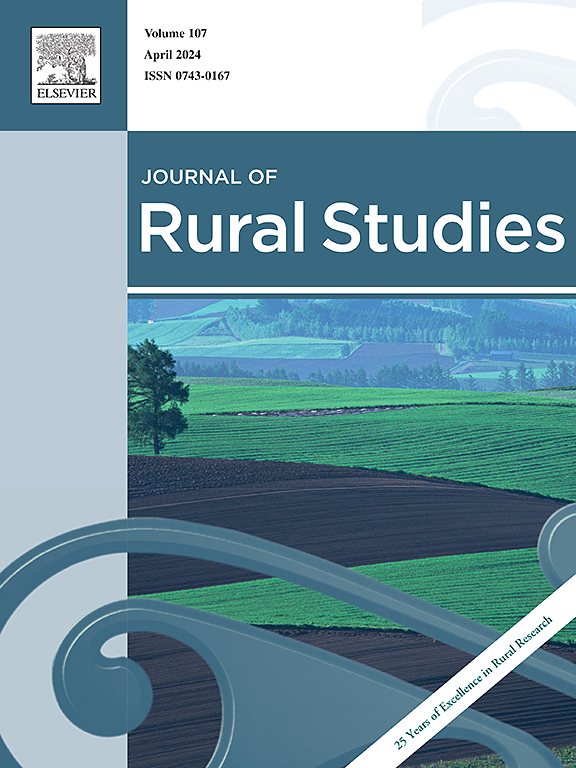Exploring the relationship between land abandonment and landscape identity in traditional cultural landscapes: the case of Castelsaraceno, Italy
IF 5.7
1区 社会学
Q1 GEOGRAPHY
引用次数: 0
Abstract
Traditional cultural landscapes are often valued for their multifunctionality and are increasingly being viewed as models for informing sustainable land management and landscape planning. However, land abandonment in Europe has contributed to the gradual decline and disappearance of traditional cultural landscapes. Although the impacts of land abandonment on traditional cultural landscapes have been widely examined from biophysical and socioeconomic perspectives, there is a knowledge gap in the study of the impacts from sociocultural ones. This paper contributes to filling this gap by exploring the relationship between land abandonment and landscape identity. To achieve this, we study the case of Castelsaraceno (Italy), a town which has historically boasted a rich agro-pastoral system and shepherding tradition, as an example of a region characterized by traditional cultural landscapes that has experienced sustained trends of land abandonment since the mid-20th century. Interviews were conducted with shepherds to understand their perceptions of land abandonment drivers, traditional land management practices, and social identity dynamics. Our findings highlight how land abandonment is perceived to have occurred predominantly through a lack of generational renewal, though underpinned by several other interacting factors which are both regionally- and site-specific, spanning to include economic conditions as well as rising social stigma and changing family dynamics. These land abandonment drivers have led to the decline of the traditional agro-pastoral practices in Castelsaraceno and to substantial changes in shepherds’ landscape identity. These changes are represented through a higher sense of disaffection towards the landscape, as well as a general sense of value loss. Amongst growing interest in land abandonment as an opportunity for novel rural development paradigms, such as nature restoration and nature-based tourism, we argue that future research and policy development concerning landscape planning should more thoroughly take past landscape dynamics into account, human experiences, values, and legacy knowledge upon which traditional cultural landscapes have been founded and sustained. Accounting for these elements can help guide transformative change and inform more sustainable and culturally sensitive landscape management planning.
探索传统文化景观中土地废弃与景观认同的关系:以意大利萨拉塞诺城堡为例
传统文化景观往往因其多功能而受到重视,并日益被视为为可持续土地管理和景观规划提供信息的典范。然而,欧洲的土地遗弃导致了传统文化景观的逐渐衰落和消失。虽然土地撂荒对传统文化景观的影响已经从生物物理和社会经济的角度进行了广泛的研究,但对社会文化影响的研究还存在知识空白。本文通过探讨土地撂荒与景观认同之间的关系来填补这一空白。为了实现这一目标,我们研究了Castelsaraceno(意大利)的案例,这是一个历史上以丰富的农牧系统和牧羊传统而自豪的城镇,作为一个以传统文化景观为特征的地区的例子,自20世纪中期以来,该地区经历了土地遗弃的持续趋势。对牧羊人进行了访谈,以了解他们对土地遗弃驱动因素、传统土地管理实践和社会认同动态的看法。我们的研究结果强调了土地遗弃是如何被认为主要是由于缺乏代际更新而发生的,尽管有其他几个相互作用的因素支持,这些因素既有区域的,也有特定地点的,包括经济条件、不断上升的社会耻辱和不断变化的家庭动态。这些土地被遗弃的驱动因素导致了Castelsaraceno传统农牧实践的衰落,并导致了牧羊人景观身份的实质性变化。这些变化表现为对景观的高度不满,以及对价值损失的普遍感觉。之间日益增长的兴趣在土地放弃一个机会为新农村发展模式,如自然恢复和自然旅游,我们认为未来研究和政策发展关于景观规划应该更彻底地考虑过去的景观动态,人类经历,价值观,和传统知识的传统文化景观已经建立和持续。考虑这些因素可以帮助指导变革,并为更具可持续性和文化敏感性的景观管理规划提供信息。
本文章由计算机程序翻译,如有差异,请以英文原文为准。
求助全文
约1分钟内获得全文
求助全文
来源期刊

Journal of Rural Studies
Multiple-
CiteScore
9.80
自引率
9.80%
发文量
286
期刊介绍:
The Journal of Rural Studies publishes research articles relating to such rural issues as society, demography, housing, employment, transport, services, land-use, recreation, agriculture and conservation. The focus is on those areas encompassing extensive land-use, with small-scale and diffuse settlement patterns and communities linked into the surrounding landscape and milieux. Particular emphasis will be given to aspects of planning policy and management. The journal is international and interdisciplinary in scope and content.
 求助内容:
求助内容: 应助结果提醒方式:
应助结果提醒方式:


